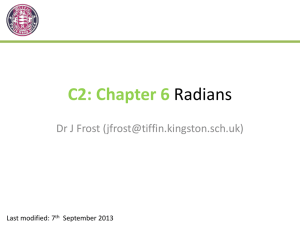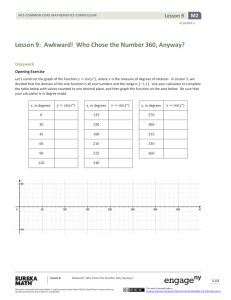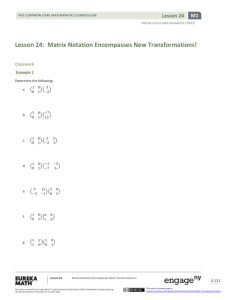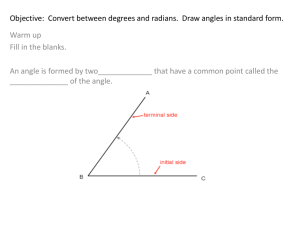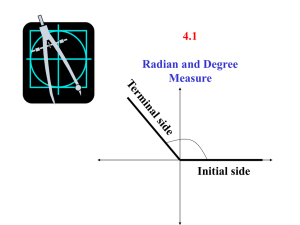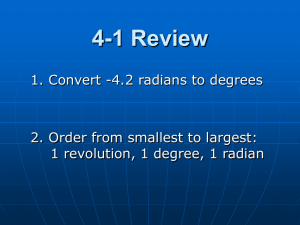Lesson 9: Awkward! Who Chose the Number 360
advertisement
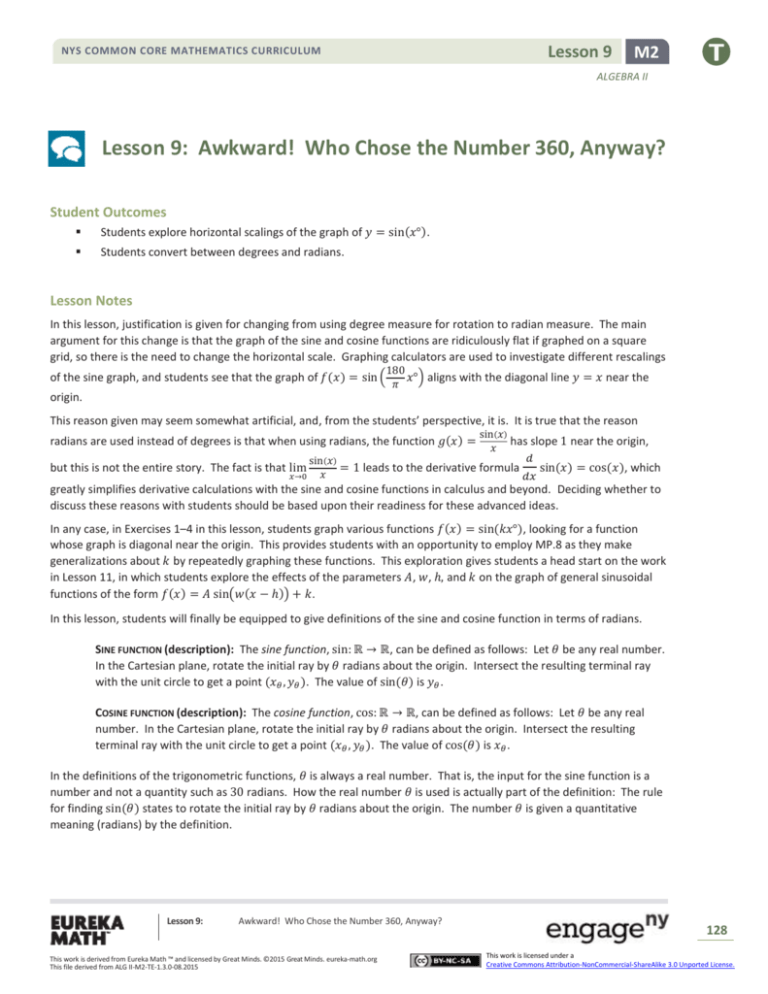
Lesson 9 NYS COMMON CORE MATHEMATICS CURRICULUM M2 ALGEBRA II Lesson 9: Awkward! Who Chose the Number 360, Anyway? Student Outcomes Students explore horizontal scalings of the graph of 𝑦 = sin(𝑥°). Students convert between degrees and radians. Lesson Notes In this lesson, justification is given for changing from using degree measure for rotation to radian measure. The main argument for this change is that the graph of the sine and cosine functions are ridiculously flat if graphed on a square grid, so there is the need to change the horizontal scale. Graphing calculators are used to investigate different rescalings of the sine graph, and students see that the graph of 𝑓(𝑥) = sin ( 180 𝑥°) aligns with the diagonal line 𝑦 = 𝑥 near the 𝜋 origin. This reason given may seem somewhat artificial, and, from the students’ perspective, it is. It is true that the reason radians are used instead of degrees is that when using radians, the function 𝑔(𝑥) = but this is not the entire story. The fact is that lim 𝑥→0 sin(𝑥) has slope 1 near the origin, 𝑥 𝑑 sin(𝑥) = 1 leads to the derivative formula sin(𝑥) = cos(𝑥), which 𝑥 𝑑𝑥 greatly simplifies derivative calculations with the sine and cosine functions in calculus and beyond. Deciding whether to discuss these reasons with students should be based upon their readiness for these advanced ideas. In any case, in Exercises 1–4 in this lesson, students graph various functions 𝑓(𝑥) = sin(𝑘𝑥°), looking for a function whose graph is diagonal near the origin. This provides students with an opportunity to employ MP.8 as they make generalizations about 𝑘 by repeatedly graphing these functions. This exploration gives students a head start on the work in Lesson 11, in which students explore the effects of the parameters 𝐴, 𝑤, ℎ, and 𝑘 on the graph of general sinusoidal functions of the form 𝑓(𝑥) = 𝐴sin(𝑤(𝑥 − ℎ)) + 𝑘. In this lesson, students will finally be equipped to give definitions of the sine and cosine function in terms of radians. SINE FUNCTION (description): The sine function, sin: ℝ → ℝ, can be defined as follows: Let 𝜃 be any real number. In the Cartesian plane, rotate the initial ray by 𝜃 radians about the origin. Intersect the resulting terminal ray with the unit circle to get a point (𝑥𝜃 , 𝑦𝜃 ). The value of sin(𝜃) is 𝑦𝜃 . COSINE FUNCTION (description): The cosine function, cos: ℝ → ℝ, can be defined as follows: Let 𝜃 be any real number. In the Cartesian plane, rotate the initial ray by 𝜃 radians about the origin. Intersect the resulting terminal ray with the unit circle to get a point (𝑥𝜃 , 𝑦𝜃 ). The value of cos(𝜃) is 𝑥𝜃 . In the definitions of the trigonometric functions, 𝜃 is always a real number. That is, the input for the sine function is a number and not a quantity such as 30 radians. How the real number 𝜃 is used is actually part of the definition: The rule for finding sin(𝜃) states to rotate the initial ray by 𝜃 radians about the origin. The number 𝜃 is given a quantitative meaning (radians) by the definition. Lesson 9: Awkward! Who Chose the Number 360, Anyway? This work is derived from Eureka Math ™ and licensed by Great Minds. ©2015 Great Minds. eureka-math.org This file derived from ALG II-M2-TE-1.3.0-08.2015 128 This work is licensed under a Creative Commons Attribution-NonCommercial-ShareAlike 3.0 Unported License. Lesson 9 NYS COMMON CORE MATHEMATICS CURRICULUM M2 ALGEBRA II Because there are two measurement systems for rotational measure, degrees and radians, there are, therefore, two different definitions of each trigonometric function—one for degrees and one for radians. The rigorous thing to do in this situation is to notate each definition differently, say by sindeg (40) to refer to a rotation by 40 degrees and sinrad (40) to refer to a rotation by 40 radians. Using two notations, of course, is unforgivably pedantic, and mathematicians long ago decided to notate the difference between the definitions of these two functions in a subtle way. Here’s the rule of thumb: sin(𝜃) always refers to the value of the sine function after rotating the initial ray by 𝜃 radians. Once radians are defined in Algebra II, this becomes the standard way to refer to almost all rotational measures and sine functions from that point on (including in precalculus and university-level calculus). To refer to the degree definition of the sine function, indicate the degree symbol on the number, as in sin(45°). Note, however, that the degree symbol in this notation refers to which definition of the sine function is being used, not that the sine function is accepting a quantity of 45° as input. In this notation, the sine function is still thought of as accepting a number, say 45, but 45 is being put into the blank in the notation sin(°). The degree symbol is referring to the definition and isn’t really part of the input. Subtle? Yes. But it is also so natural that students will never really question its use. There is no need to explicitly explain this subtlety; just be clear about how to use and apply the notation correctly and consistently. Materials For the Problem Set, students need access to a radian protractor. An inexpensive way to obtain these is to copy the images from the last page onto transparencies, cut out the protractors, and distribute to students. Classwork Opening Exercise (8 minutes) The first step in understanding why there is a need to change how angles of rotation are measured is to try to graph the sine function on a grid with the same horizontal and vertical scale. Allow students to struggle with this task and to come to the conclusion that either the horizontal or the vertical scale needs to change in order to be able to even see the graph of 𝑦 = sin(𝑥°). Scaffolding: Opening Exercise Let’s construct the graph of the function 𝒚 = 𝐬𝐢𝐧(𝒙°), where 𝒙 is the measure of degrees of rotation. In Lesson 5, we decided that the domain of the sine function is all real numbers and the range is [−𝟏, 𝟏]. Use your calculator to complete the table below with values rounded to one decimal place, and then graph the function on the axes below. Be sure that your calculator is in degree mode. 𝒙, in degrees 𝟎 𝟑𝟎 𝟒𝟓 𝟔𝟎 𝟗𝟎 𝟏𝟐𝟎 𝒚 = 𝐬𝐢𝐧(𝒙°) 𝟎. 𝟎 𝟎. 𝟓 𝟎. 𝟕 𝟎. 𝟗 𝟏. 𝟎 𝟎. 𝟗 Lesson 9: 𝒙, in degrees 𝟏𝟑𝟓 𝟏𝟓𝟎 𝟏𝟖𝟎 𝟐𝟏𝟎 𝟐𝟐𝟓 𝟐𝟒𝟎 𝒚 = 𝐬𝐢𝐧(𝒙°) 𝟎. 𝟕 𝟎. 𝟓 𝟎. 𝟎 −𝟎. 𝟓 −𝟎. 𝟕 −𝟎. 𝟗 Awkward! Who Chose the Number 360, Anyway? This work is derived from Eureka Math ™ and licensed by Great Minds. ©2015 Great Minds. eureka-math.org This file derived from ALG II-M2-TE-1.3.0-08.2015 𝒙, in degrees 𝟐𝟕𝟎 𝟑𝟎𝟎 𝟑𝟏𝟓 𝟑𝟑𝟎 𝟑𝟔𝟎 Students above grade level can plot points in 15 degree increments to get a better image of the graph. 𝒚 = 𝐬𝐢𝐧(𝒙°) −𝟏. 𝟎 −𝟎. 𝟗 −𝟎. 𝟕 −𝟎. 𝟓 𝟎. 𝟎 129 This work is licensed under a Creative Commons Attribution-NonCommercial-ShareAlike 3.0 Unported License. Lesson 9 NYS COMMON CORE MATHEMATICS CURRICULUM M2 ALGEBRA II Discussion (4 minutes) This discussion should lead to the conclusion that the best way to “fix” the problem of graphing 𝑦 = sin(𝑥°) while retaining a one-to-one ratio of the scales on the axes would be to perform a horizontal scaling to compress the graph along the horizontal axis. The first step is to guide students to recognize the nature of the problem they’re facing. What do you notice about the graph that you created in the Opening Exercise? Creating a useful graph is impossible on the set of axes provided. In Lesson 30 of Module 1, we performed transformations on a parabola that changed its horizontal scale. How did we do that? 1 𝑘 2 When we graphed 𝑦 = 𝑥 2 and 𝑦 = ( 𝑥) , the second graph was stretched horizontally by a factor of 𝑘. What horizontal scaling can we perform to compress the parabola 𝑦 = 𝑥 2 to make the graph twice as narrow as the original graph? What might be a reasonable transformation to perform on the sine function to make the graph narrower? 𝑦 = (2𝑥)2 Any transformation of the form 𝑦 = sin(𝑘𝑥°) for 𝑘 ≥ 1 will work; students may suggest 𝑦 = sin(2𝑥°) or 𝑦 = sin(10𝑥°). Do we really know which transformation would be the best? Maybe we should stop to think about what we want to transform this graph into before we proceed. Lesson 9: Awkward! Who Chose the Number 360, Anyway? This work is derived from Eureka Math ™ and licensed by Great Minds. ©2015 Great Minds. eureka-math.org This file derived from ALG II-M2-TE-1.3.0-08.2015 130 This work is licensed under a Creative Commons Attribution-NonCommercial-ShareAlike 3.0 Unported License. Lesson 9 NYS COMMON CORE MATHEMATICS CURRICULUM M2 ALGEBRA II Exercises 1–4 (8 minutes) Place students in small groups and keep them working in these groups for all of the exercises in this lesson. Exercises 1–5 Set your calculator’s viewing window to 𝟎 ≤ 𝒙 ≤ 𝟏𝟎 and −𝟐. 𝟒 ≤ 𝒚 ≤ 𝟐. 𝟒, and be sure that your calculator is in degree mode. Plot the following functions in the same window: 𝒚 = 𝐬𝐢𝐧(𝒙°) 𝒚 = 𝐬𝐢𝐧(𝟐𝒙°) 𝒚 = 𝐬𝐢𝐧(𝟏𝟎𝒙°) 𝒚 = 𝐬𝐢𝐧(𝟓𝟎𝒙°) 𝒚 = 𝐬𝐢𝐧(𝟏𝟎𝟎𝒙°) 1. This viewing window was chosen because it has close to the same scale in the horizontal and vertical directions. In this viewing window, which of the five transformed sine functions most clearly shows the behavior of the sine function? Students may answer 𝒚 = 𝐬𝐢𝐧(𝟓𝟎𝒙°) or 𝒚 = 𝐬𝐢𝐧(𝟏𝟎𝟎𝒙°). (Either answer is reasonable.) MP.8 Describe the relationship between the steepness of the graph 𝒚 = 𝐬𝐢𝐧(𝒌𝒙°) near the origin and the value of 𝒌. 2. As we increase 𝒌, the steepness of the graph 𝒚 = 𝐬𝐢𝐧(𝒌𝒙°) near the origin increases. Since we can control the steepness of the graph 𝒚 = 𝐬𝐢𝐧(𝒌𝒙°) near the origin by changing the value of 𝒌, how steep might we want this graph to be? What is your favorite positive slope for a line through the origin? 3. It would make sense to try to get the steepness at the origin to be the same as the diagonal line 𝒚 = 𝒙, which has slope 𝟏. In the same viewing window on your calculator, plot 𝒚 = 𝒙 and 𝒚 = 𝐬𝐢𝐧(𝒌𝒙°) for some value of 𝒌. Experiment with your calculator to find a value of 𝒌 so that the steepness of 𝒚 = 𝐬𝐢𝐧(𝒌𝒙°) matches the slope of the line 𝒚 = 𝒙 near the origin. You may need to change your viewing window to 𝟎 ≤ 𝒙 ≤ 𝟐 and 𝟎 ≤ 𝒚 ≤ 𝟏 to determine the best value of 𝒌. 4. The graph of 𝒚 = 𝐬𝐢𝐧(𝟓𝟕𝒙°) has nearly the same steepness as the diagonal line with equation 𝒚 = 𝒙. Discussion (4 minutes) Which values of 𝑘 produce graphs of 𝑦 = sin(𝑘𝑥°) that are close to the graph of 𝑦 = 𝑥 near the origin? Responses will vary; they should be near 𝑘 = 57. It looks like choosing 𝑘 = 57 is close to what we want. But why 57? Something is strange here! And, indeed, there is something both surprising and natural about what the value of 𝑘 truly is. First, let’s review our basic system of measurement for rotation. We could take the entire circle as the unit of rotational measure; this is known as a turn. Then, a rotation can be expressed as a fraction of a turn. For 1 1 4 2 example, turn would correspond to a right angle, and of a turn would correspond to a straight angle. Instead, we more commonly use a small unit called a degree. We divide the circle into 360 arcs of equal length, and then the central angle subtended by one of these arcs has measure 1 degree. Then, a turn measures 360°. Lesson 9: Awkward! Who Chose the Number 360, Anyway? This work is derived from Eureka Math ™ and licensed by Great Minds. ©2015 Great Minds. eureka-math.org This file derived from ALG II-M2-TE-1.3.0-08.2015 131 This work is licensed under a Creative Commons Attribution-NonCommercial-ShareAlike 3.0 Unported License. Lesson 9 NYS COMMON CORE MATHEMATICS CURRICULUM M2 ALGEBRA II Who came up with our current system of using 360° in a turn? Remember the ancient Babylonians who made all of those astronomical observations that led to the discovery of trigonometry? They are also the ones responsible for our system of measuring rotations and angles. It appears that the Babylonians subdivided the circle using the angle of an equilateral triangle as the basic unit. Since they used a base-60 number system, they divided each angle of the equilateral triangle into 60 smaller units, each with measure 1 degree, giving 360 degrees in a turn. Each degree is subdivided into 60 minutes, and each minute is subdivided into 60 seconds. For our purposes now, using 360° in a turn is cumbersome. Instead of basing our measurement system on an arbitrary number like 360, we will instead use a system in which the measures of angles and rotations are determined by the length of the corresponding arc of a unit circle. A circle is defined by a point and a radius. If we start with a circle of any radius and look at a sector of that circle with an arc length equal to the length of the radius, then the central angle of that sector is always the same size. We define a radian to be the measure of that central angle and denote it by 𝟏𝐫𝐚𝐝. Thus, a radian measures how far one radius will wrap around the circle. For any circle, it takes 𝟐𝝅 ≈ 𝟔. 𝟑 radius lengths to wrap around the circumference. In the figure, 𝟔 radius lengths are shown around the circle, with roughly 𝟎. 𝟑 radius lengths left over. Lesson 9: Awkward! Who Chose the Number 360, Anyway? This work is derived from Eureka Math ™ and licensed by Great Minds. ©2015 Great Minds. eureka-math.org This file derived from ALG II-M2-TE-1.3.0-08.2015 132 This work is licensed under a Creative Commons Attribution-NonCommercial-ShareAlike 3.0 Unported License. Lesson 9 NYS COMMON CORE MATHEMATICS CURRICULUM M2 ALGEBRA II Exercise 5 (2 minutes) Allow students time to discuss this with a partner in order to make the connection between the 57° measured in this exercise and the 𝑘 = 57 scale factor that was discovered in Exercise 4. 5. Use a protractor that measures angles in degrees to find an approximate degree measure for an angle with measure 𝟏𝐫𝐚𝐝. Use one of the figures from the previous discussion. We find that the degree measure of an angle that has measure 𝟏𝐫𝐚𝐝 is approximately 𝟓𝟕°. Examples 1–4 (4 minutes) Instead of emphasizing conversion formulas for switching between degrees and radians, emphasize that both systems 1 𝜋 6 3 can be thought of as fractions of a turn. Thus, a 60° rotation is of a turn, which is radians, and 𝜋 radians is a half- turn, which is 180°. Examples 1–4 1. Convert from degrees to radians: 𝟒𝟓° 𝟏 𝐭𝐮𝐫𝐧 𝟖 𝟏 = (𝟐𝝅)𝐫𝐚𝐝 𝟖 𝝅 = 𝐫𝐚𝐝 𝟒 𝟒𝟓° = 2. Convert from degrees to radians: 𝟑𝟑° 𝟑𝟑 𝐭𝐮𝐫𝐧 𝟑𝟔𝟎 𝟑𝟑 =( ) 𝟐𝝅𝐫𝐚𝐝 𝟑𝟔𝟎 𝟏𝟏 = ( ) 𝝅𝐫𝐚𝐝 𝟔𝟎 𝟑𝟑° = 3. 𝝅 𝟑 Convert from radians to degrees: − 𝐫𝐚𝐝 − 4. Convert from radians to degrees: 𝟏𝟗𝝅 𝟏𝟕 𝝅 𝟏 𝐫𝐚𝐝 = − ( ) 𝐭𝐮𝐫𝐧 𝟑 𝟔 𝟏 = − ( ) 𝟑𝟔𝟎° 𝟔 = −𝟔𝟎° 𝐫𝐚𝐝 𝟏𝟗𝝅 𝟏𝟗 𝟏 𝐫𝐚𝐝 = ( ) ( ) 𝐭𝐮𝐫𝐧 𝟏𝟕 𝟏𝟕 𝟐 𝟏𝟗 = ( ) 𝟑𝟔𝟎° 𝟑𝟒 ≈ 𝟐𝟎𝟏° Lesson 9: Awkward! Who Chose the Number 360, Anyway? This work is derived from Eureka Math ™ and licensed by Great Minds. ©2015 Great Minds. eureka-math.org This file derived from ALG II-M2-TE-1.3.0-08.2015 133 This work is licensed under a Creative Commons Attribution-NonCommercial-ShareAlike 3.0 Unported License. Lesson 9 NYS COMMON CORE MATHEMATICS CURRICULUM M2 ALGEBRA II Exercise 6 (3 minutes) Have students perform the following conversions either alone or in small groups to complete this chart. Circulate around the room to monitor student progress, especially for the last conversion that is critical to the conclusion students should make in this lesson. Exercises 6–7 6. Complete the table below, converting from degrees to radians or from radians to degrees as necessary. Leave your answers in exact form, involving 𝝅. Degrees Radians 𝟒𝟓° 𝝅 𝟒 𝟏𝟐𝟎° 𝟐𝝅 𝟑 −𝟏𝟓𝟎° − 𝟓𝝅 𝟔 𝟐𝟕𝟎° 𝟑𝝅 𝟐 𝟒𝟓𝟎° 𝟓𝝅 𝟐 ( 𝒙° 𝟏𝟖𝟎 ( ) 𝒙° 𝝅 𝝅 )𝒙 𝟏𝟖𝟎 𝒙 Exercise 7 (3 minutes) This question ties together the previous exploration looking for a transformed sine function that is diagonal near the origin and our newly defined radian measure for angles. Allow students to continue to work in their groups on these questions. 7. On your calculator, graph the functions 𝒚 = 𝒙 and 𝒚 = 𝐬𝐢𝐧 ( the decimal approximation to the constant 𝟏𝟖𝟎 𝝅 𝟏𝟖𝟎 𝒙°). What do you notice near the origin? What is 𝝅 to one decimal place? Explain how this relates to what we’ve done in Exercise 4. 𝟏𝟖𝟎 𝒙°) is nearly identical to the graph of𝒚 = 𝒙 near the origin. On the calculator, we see 𝝅 𝟏𝟖𝟎 𝟏𝟖𝟎 that ≈ 𝟓𝟕. 𝟑 so that 𝐬𝐢𝐧 ( 𝒙°) ≈ 𝐬𝐢𝐧(𝟓𝟕𝒙°). This is the function we were looking for in Exercise 4. 𝝅 𝝅 The graph of 𝒚 = 𝐬𝐢𝐧 ( Lesson 9: Awkward! Who Chose the Number 360, Anyway? This work is derived from Eureka Math ™ and licensed by Great Minds. ©2015 Great Minds. eureka-math.org This file derived from ALG II-M2-TE-1.3.0-08.2015 134 This work is licensed under a Creative Commons Attribution-NonCommercial-ShareAlike 3.0 Unported License. Lesson 9 NYS COMMON CORE MATHEMATICS CURRICULUM M2 ALGEBRA II Discussion (2 minutes) If degrees are changed to radians, then the expression sin ( 180 𝑥°), where 𝑥 is measured in degrees, becomes sin(𝑥), 𝜋 where 𝑥 is measured in radians. Then one period of the graph of 𝑦 = sin(𝑥) on a grid with the same scale on the horizontal and vertical axes now looks like this: From this point forward, trigonometric functions will always be graphed using radians for measuring rotation instead of degrees. Besides the discovery that the graph of the sine function is much easier to create and use in radians, it turns out that radians make many calculations much easier in later work in mathematics. Closing (3 minutes) Ask students to summarize the main points of the lesson either in writing, to a partner, or as a class. A radian is the measure of the central angle of a sector of a circle with arc length of one radius length. If there is no degree symbol or specification, then the use of radians is implied. There are 2𝜋 radians in a 360° rotation, also known as a turn, so degrees are converted to radians and radians to degrees by: 2𝜋rad = 1turn = 360°. From this point forward, all work will be done with radian measures exclusively for rotation and as the independent variables in the trigonometric functions. The diagram is nearly the same as the one for the sine and cosine functions in Lesson 4, but this time it is labeled with rotations measured in radians. Use the diagram to find cos ( 7𝜋 𝜋 ) and sin (− ) 6 6 √3 7𝜋 )=− 6 2 𝜋 1 sin (− ) = − 6 2 cos ( Lesson 9: Awkward! Who Chose the Number 360, Anyway? This work is derived from Eureka Math ™ and licensed by Great Minds. ©2015 Great Minds. eureka-math.org This file derived from ALG II-M2-TE-1.3.0-08.2015 135 This work is licensed under a Creative Commons Attribution-NonCommercial-ShareAlike 3.0 Unported License. NYS COMMON CORE MATHEMATICS CURRICULUM Lesson 9 M2 ALGEBRA II Lesson Summary A radian is the measure of the central angle of a sector of a circle with arc length of one radius length. There are 𝟐𝝅 radians in a 𝟑𝟔𝟎° rotation, also known as a turn, so degrees are converted to radians and radians to degrees by: 𝟐𝝅𝐫𝐚𝐝 = 𝟏𝐭𝐮𝐫𝐧 = 𝟑𝟔𝟎°. SINE FUNCTION (description): The sine function, 𝐬𝐢𝐧: ℝ → ℝ, can be defined as follows: Let 𝜽 be any real number. In the Cartesian plane, rotate the initial ray by 𝜽 radians about the origin. Intersect the resulting terminal ray with the unit circle to get a point (𝒙𝜽 , 𝒚𝜽 ). The value of 𝐬𝐢𝐧(𝜽) is 𝒚𝜽 . COSINE FUNCTION (description): The cosine function, 𝐜𝐨𝐬: ℝ → ℝ, can be defined as follows: Let 𝜽 be any real number. In the Cartesian plane, rotate the initial ray by 𝜽 radians about the origin. Intersect the resulting terminal ray with the unit circle to get a point (𝒙𝜽 , 𝒚𝜽 ). The value of 𝐜𝐨𝐬(𝜽) is 𝒙𝜽 . Exit Ticket (4 minutes) Lesson 9: Awkward! Who Chose the Number 360, Anyway? This work is derived from Eureka Math ™ and licensed by Great Minds. ©2015 Great Minds. eureka-math.org This file derived from ALG II-M2-TE-1.3.0-08.2015 136 This work is licensed under a Creative Commons Attribution-NonCommercial-ShareAlike 3.0 Unported License. Lesson 9 NYS COMMON CORE MATHEMATICS CURRICULUM M2 ALGEBRA II Name Date Lesson 9: Awkward! Who Chose the Number 360, Anyway? Exit Ticket 1. Convert 60° to radians. 2. Convert − rad to degrees. 3. Explain how radian measure is related to the radius of a circle. Draw and label an appropriate diagram to support your response. 𝜋 2 Lesson 9: Awkward! Who Chose the Number 360, Anyway? This work is derived from Eureka Math ™ and licensed by Great Minds. ©2015 Great Minds. eureka-math.org This file derived from ALG II-M2-TE-1.3.0-08.2015 137 This work is licensed under a Creative Commons Attribution-NonCommercial-ShareAlike 3.0 Unported License. Lesson 9 NYS COMMON CORE MATHEMATICS CURRICULUM M2 ALGEBRA II Exit Ticket Sample Solutions 1. Convert 𝟔𝟎° to radians. 𝝅 𝟔𝟎° = 𝐫𝐚𝐝 𝟑 2. 𝝅 𝟐 Convert − 𝐫𝐚𝐝 to degrees. − 3. 𝝅 𝐫𝐚𝐝 = −𝟗𝟎° 𝟐 Explain how radian measure is related to the radius of a circle. Draw and label an appropriate diagram to support your response. If we take one radius from the circle and wrap it part of the way around the circle, the central angle with the arc length of one radius has measure one radian. Problem Set Sample Solutions For Problem 1, students need to have access to a protractor that measures in radians. The majority of the problems in this Problem Set are designed to build fluency with radians and encourage the shift from thinking in terms of degrees to thinking in terms of radians. For Problem 12, ask students to compare the lengths they calculate to the lengths found at http://en.wikipedia.org/wiki/Latitude. 1. Use a radian protractor to measure the amount of rotation in radians of ray 𝑩𝑨 to ray 𝑩𝑪 in the indicated direction. Measure to the nearest 𝟎. 𝟏 radian. Use negative measures to indicate clockwise rotation. a. b. 𝟏. 𝟕𝐫𝐚𝐝 Lesson 9: Awkward! Who Chose the Number 360, Anyway? This work is derived from Eureka Math ™ and licensed by Great Minds. ©2015 Great Minds. eureka-math.org This file derived from ALG II-M2-TE-1.3.0-08.2015 −𝟒. 𝟔𝐫𝐚𝐝 138 This work is licensed under a Creative Commons Attribution-NonCommercial-ShareAlike 3.0 Unported License. Lesson 9 NYS COMMON CORE MATHEMATICS CURRICULUM M2 ALGEBRA II c. d. −𝟑. 𝟒𝐫𝐚𝐝 𝟐. 𝟔𝐫𝐚𝐝 f. e. −𝟐. 𝟏𝐫𝐚𝐝 𝟒. 𝟐𝐫𝐚𝐝 g. h. −𝟎. 𝟒𝐫𝐚𝐝 2. 𝟓. 𝟖𝐫𝐚𝐝 Complete the table below, converting from degrees to radians. Where appropriate, give your answers in the form of a fraction of 𝝅. Degrees 𝟗𝟎° 𝟑𝟎𝟎° −𝟒𝟓° −𝟑𝟏𝟓° −𝟔𝟗𝟎° 𝟑 𝟑 ° 𝟒 𝟗𝟎𝝅° − Lesson 9: 𝟒𝟓° 𝝅 Radians 𝝅 𝟐 𝟓𝝅 𝟑 𝝅 − 𝟒 𝟕𝝅 − 𝟒 𝟐𝟑𝝅 − 𝟔 𝝅 𝟒𝟖 𝝅𝟐 𝟐 𝟏 − 𝟒 Awkward! Who Chose the Number 360, Anyway? This work is derived from Eureka Math ™ and licensed by Great Minds. ©2015 Great Minds. eureka-math.org This file derived from ALG II-M2-TE-1.3.0-08.2015 139 This work is licensed under a Creative Commons Attribution-NonCommercial-ShareAlike 3.0 Unported License. Lesson 9 NYS COMMON CORE MATHEMATICS CURRICULUM M2 ALGEBRA II 3. Complete the table below, converting from radians to degrees. Radians 𝝅 𝟒 𝝅 Degrees 𝟒𝟓° 𝟑𝟎° 𝟔 𝟓𝝅 𝟏𝟐 𝟏𝟏𝝅 𝟑𝟔 𝟕𝝅 − 𝟐𝟒 𝟏𝟏𝝅 − 𝟏𝟐 4. 𝟕𝟓° 𝟓𝟓° −𝟓𝟐. 𝟓° −𝟏𝟔𝟓° 𝟒𝟗𝝅 𝟖𝟖𝟐𝟎° 𝟒𝟗𝝅 𝟑 𝟐𝟗𝟒𝟎° Use the unit circle diagram from the end of the lesson and your knowledge of the six trigonometric functions to complete the table below. Give your answers in exact form, as either rational numbers or radical expressions. 𝜽 𝐜𝐨𝐬(𝜽) 𝐬𝐢𝐧(𝜽) 𝐭𝐚𝐧(𝜽) 𝐜𝐨𝐭(𝜽) 𝐬𝐞𝐜(𝜽) 𝐜𝐬𝐜(𝜽) 𝝅 𝟑 𝟏 𝟐 √𝟑 𝟐 √𝟑 √𝟑 𝟑 𝟐 𝟐√𝟑 𝟑 −𝟏 −𝟏 −√𝟐 √𝟐 𝟑𝝅 𝟒 − √𝟐 𝟐 √𝟐 𝟐 𝟓𝝅 𝟔 − √𝟑 𝟐 𝟏 𝟐 𝟏 𝟎 𝟎 undefined 𝟏 undefined √𝟐 𝟐 𝟏 𝟏 −√𝟐 −√𝟐 𝟎 − 𝟑𝝅 𝟒 − √𝟐 𝟐 − 𝟕𝝅 𝟔 − √𝟑 𝟐 − 𝟏𝟏𝝅 𝟑 𝟏 𝟐 Lesson 9: − 𝟏 𝟐 √𝟑 𝟐 − − √𝟑 𝟑 √𝟑 𝟑 √𝟑 −√𝟑 −√𝟑 √𝟑 𝟑 Awkward! Who Chose the Number 360, Anyway? This work is derived from Eureka Math ™ and licensed by Great Minds. ©2015 Great Minds. eureka-math.org This file derived from ALG II-M2-TE-1.3.0-08.2015 − − 𝟐√𝟑 𝟑 𝟐√𝟑 𝟑 𝟐 𝟐 𝟐 𝟐√𝟑 𝟑 140 This work is licensed under a Creative Commons Attribution-NonCommercial-ShareAlike 3.0 Unported License. Lesson 9 NYS COMMON CORE MATHEMATICS CURRICULUM M2 ALGEBRA II 5. Use the unit circle diagram from the end of the lesson and your knowledge of the sine, cosine, and tangent functions to complete the table below. Select values of 𝜽 so that 𝟎 ≤ 𝜽 < 𝟐𝝅. 𝜽 𝐜𝐨𝐬(𝜽) 𝟓𝝅 𝟑 𝟏 𝟐 − √𝟑 𝟐 −√𝟑 − √𝟐 𝟐 𝟏 𝟓𝝅 𝟒 − √𝟐 𝟐 𝟑𝝅 𝟒 − √𝟐 𝟐 𝐭𝐚𝐧(𝜽) √𝟐 𝟐 −𝟏 𝝅 −𝟏 𝟎 𝟎 𝟑𝝅 𝟐 𝟎 −𝟏 undefined √𝟑 𝟐 − 𝟕𝝅 𝟔 6. 𝐬𝐢𝐧(𝜽) − 𝟏 𝟐 √𝟑 𝟑 How many radians does the minute hand of a clock rotate through over 𝟏𝟎 minutes? How many degrees? In 𝟏𝟎 minutes, the minute hand makes 𝟏 𝟔 of a rotation, so it rotates through 𝟏 𝟔 (𝟐𝝅) = 𝝅 𝟑 radians. This is equivalent to 𝟔𝟎°. 7. How many radians does the minute hand of a clock rotate through over half an hour? How many degrees? In 𝟑𝟎 minutes, the minute hand makes 𝟏 𝟐 of a rotation, so it rotates through 𝟏 𝟐 (𝟐𝝅) = 𝝅 radians. This is equivalent to 𝟏𝟖𝟎°. 8. What is the radian measure of an angle subtended by an arc of a circle with radius 𝟒𝐜𝐦 if the intercepted arc has length 𝟏𝟒𝐜𝐦? How many degrees? The intercepted arc is the length of 𝟑. 𝟓 radii, so the angle subtended by that arc measures 𝟑. 𝟓 radians. This is equivalent to 𝟑. 𝟓 ( 9. 𝟏𝟖𝟎° 𝟔𝟑𝟎° )= ≈ 𝟐𝟎𝟎. 𝟓°. 𝝅 𝝅 What is the radian measure of an angle formed by the minute and hour hands of a clock when the clock reads 1:30? How many degrees? (Hint: You must take into account that the hour hand is not directly on the 𝟏.) At 1:30, the hour hand is halfway between the 𝟏 and the 𝟐, and the minute hand is on the 𝟔. A hand on the clock rotates through 𝟏 𝟏𝟐 𝟏 𝟐 𝟏 of a rotation as it moves from one number to the next. Since there are 𝟒 of these increments between the two hands of the clock at 1:30, the angle formed by the two clock hands is 𝟗 ( ) (𝟐𝝅) = 𝟐 𝟏𝟐 𝟑𝝅 𝟒 radians. In degrees, this is 𝟏𝟑𝟓°. Lesson 9: Awkward! Who Chose the Number 360, Anyway? This work is derived from Eureka Math ™ and licensed by Great Minds. ©2015 Great Minds. eureka-math.org This file derived from ALG II-M2-TE-1.3.0-08.2015 141 This work is licensed under a Creative Commons Attribution-NonCommercial-ShareAlike 3.0 Unported License. Lesson 9 NYS COMMON CORE MATHEMATICS CURRICULUM M2 ALGEBRA II 10. What is the radian measure of an angle formed by the minute and hour hands of a clock when the clock reads 5:45? How many degrees? At 5:45, the hour hand is 𝟏 𝟒 𝟑 𝟒 of the way between the 𝟓 and 𝟔 on the clock face, and the minute hand is on the 𝟗. Then there are 𝟑 increments of two clock hands is ( 𝟏 𝟏𝟐 of a rotation between the two hands of the clock at 5:45, so the angle formed by the 𝟏𝟑𝝅 𝟏𝟖𝟎° 𝟏𝟑 𝟏 𝟏𝟑 ) ( ) (𝟐𝝅) = 𝝅 radians. This is equivalent to ( 𝝅 ) = 𝟗𝟕. 𝟓°. 𝟒 𝟏𝟐 𝟐𝟒 𝟐𝟒 11. How many degrees does the earth revolve on its axis each hour? How many radians? The earth revolves through 𝟑𝟔𝟎° in 𝟐𝟒 hours, so it revolves 𝟑𝟔𝟎° 𝟐𝟒 = 𝟏𝟓° each hour. 12. The distance from the equator to the North Pole is almost exactly 𝟏𝟎, 𝟎𝟎𝟎𝐤𝐦. a. Roughly how many kilometers is 𝟏 degree of latitude? There are 𝟗𝟎degrees of latitude between the equator and the North Pole, so each degree of latitude is 𝟏 𝟗𝟎 b. (𝟏𝟎𝟎𝟎𝟎) ≈ 𝟏𝟏𝟏. 𝟏𝐤𝐦. Roughly how many kilometers is 𝟏 radian of latitude? There are 𝟐 𝝅 𝝅 𝟐 radians of latitude between the equator and the North Pole, so each radian of latitude is (𝟏𝟎, 𝟎𝟎𝟎) ≈ 𝟔, 𝟑𝟔𝟔. 𝟐𝐤𝐦. Lesson 9: Awkward! Who Chose the Number 360, Anyway? This work is derived from Eureka Math ™ and licensed by Great Minds. ©2015 Great Minds. eureka-math.org This file derived from ALG II-M2-TE-1.3.0-08.2015 142 This work is licensed under a Creative Commons Attribution-NonCommercial-ShareAlike 3.0 Unported License. NYS COMMON CORE MATHEMATICS CURRICULUM Lesson 9 M2 ALGEBRA II Supplementary Transparency Materials Lesson 9: Awkward! Who Chose the Number 360, Anyway? This work is derived from Eureka Math ™ and licensed by Great Minds. ©2015 Great Minds. eureka-math.org This file derived from ALG II-M2-TE-1.3.0-08.2015 143 This work is licensed under a Creative Commons Attribution-NonCommercial-ShareAlike 3.0 Unported License.
